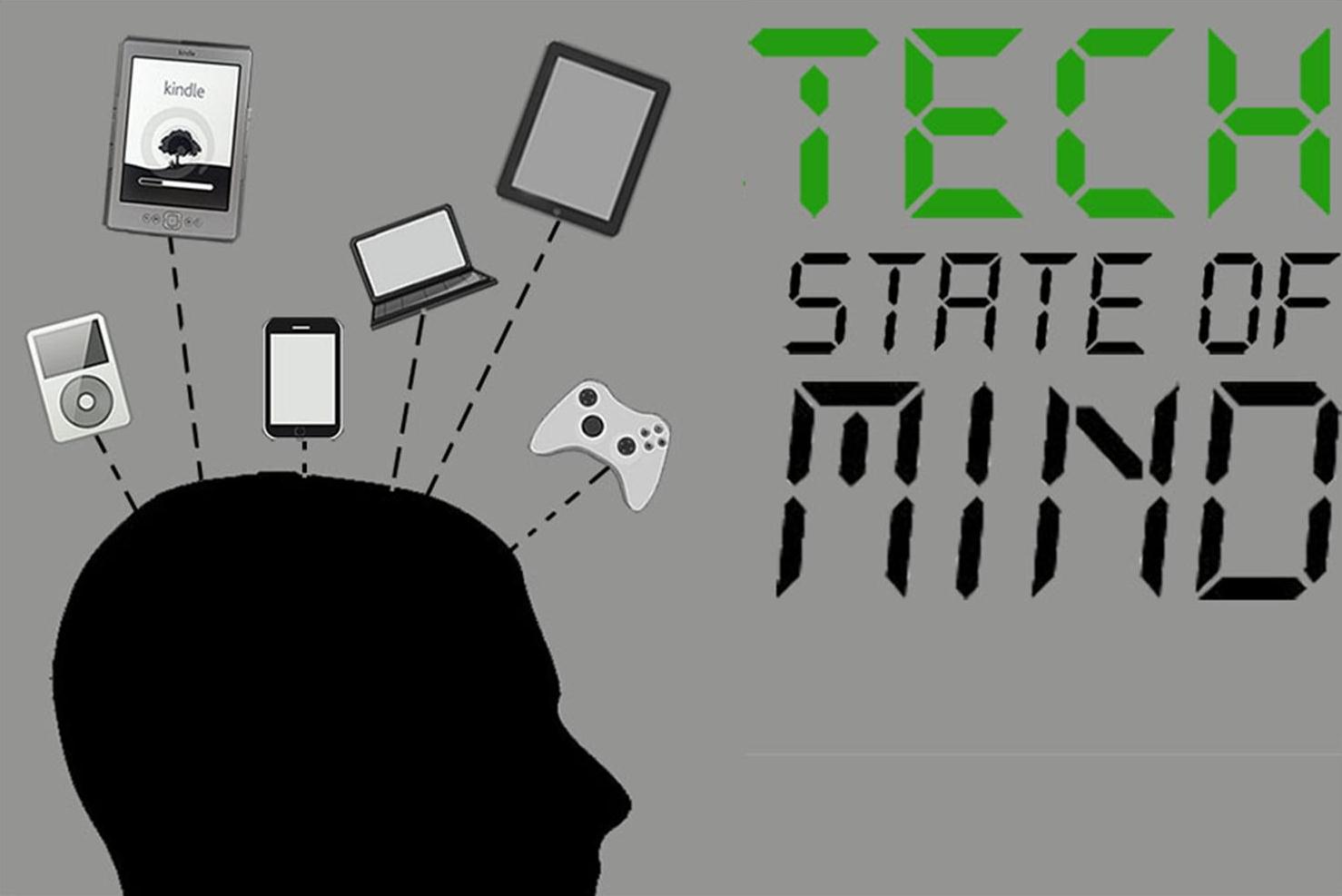Tech state of mind: The Web turns 25
In a series of short articles, we delve into the state of Web-related technology
March 17, 2014
Since the invention of the World Wide Web, technology has woven itself into the daily lives of Americans. The Web was the spark for the heavy technology use of today.
In recognition of the 25 years of the Web’s existence, the Pew Research Center has released a series of eight reports about “emerging trends in digital technology.” The research center is part of the Pew Charitable Trusts, a non-profit research organization.
Stating that using the Web is “the main activity for hundreds of millions of people around the globe,” Pew has been documenting trends on the Web since 1995.
In this feature, our team takes a closer look at different aspects of the Web.
Scroll through the entire report or use the menu at the top right to go directly to the posts you want to read.
In Communication Technology Evolves, I focus on the evolution of technology and how it has changed the way people obtain and exchange information.
Whether the Internet has been a good or bad thing is controversial. Daisy Draper gets the opinions of KS Maui students in her article, Most Feel Good About the Web.
Advancing technology has resulted in younger generations that are changing drastically from previous ones. Draper’s second article looks at the use of technology by today’s children in Internet Infused in Lives of Teens, ‘Tweens, Littlest Beings.
In fact, technology has been at the top of children’s wish lists for several years. Maile Sur writes about how a new generation is constantly being exposed to high-tech products that have changed the definition of childhood playthings in Technology for Toys.
Technology has made impacts of varying degrees on all age groups. As the older generation struggles to play catch-up, the Millennial’s keep pulling ahead, creating a giant gap between the generations. Jaylin Kekiwi tries to help in her humorous feature Crossing the Line: The Technology Generation Gap.
Surrounded by all of this technology, we couldn’t help but pause and wonder about the 13% of Americans who aren’t online. I share the story of one member of the elder generation and the reasons she and others remain unplugged in Status: Offline.
Then, take another look at something that divides the generations: texting acronyms. In which generation are you? Check out Kekiwi’s article, Been Around the World, Do YOU Speak the Language?
Last, the introduction of wireless connection has made it possible for people to stay in touch virtually anywhere. It has created a new lifestyle for people where many think they can’t live without it. Could people be too attached to technology? Sur ends our series by taking a look at people too tethered to technology in Time to Unplug.
People are constantly wanting to get their hands on the next big thing, but who knows what that next big thing will look like? We can guess that people will always want technology to be faster, newer and easier, giving other journalists something to write about when, someday, they look back on fifty years of the World Wide Web.
This chapter was written by Destinee Murray.

Communication and distribution of information has changed so much over the years with the evolution of technology.
Communication technology evolves
From cave drawings to Wikipedia, mankind has relentlessly pursued new ways to communicate information
With the help of technology, the efficiency of sending and receiving information has progressed from cave drawings to instant messaging.
Now, information-seekers have literally thousands of ways to get answers, from conferencing in video calls, to searching hashtags on social media, and to watching just about anything on mobile devices from the comfort of a home or remote location, but it wasn’t always like that.
Ancient Romans had their Acta Diurna, or daily acts, which were the first newspapers. However, these were not written on paper, but rather stone and metal, and they included a lot of what is seen today in newspapers: military victories, sports (gladiatorial bouts), birth and death notices, and human interest stories.

For the most part, though, people continued to receive information by word of mouth, hand-written or hand-copied letters and manuscripts, or limited-run works printed on early printing presses until Johannes Gutenberg invented a superior mechanical movable printing press in the 1440’s, and the possibility for spreading information took a quantum leap forward.
By the early 1600’s several cities in Europe had weekly newspapers, and not long after, in 1690, America got its first newspaper, Publick Occurences.

Within a century, American newspapers were being printed daily, and the public was clamoring for more and more information. In the 1830’s, homing pigeons and the Pony Express brought news and printed materials to remote locations across a quickly growing United States of America. The Pony Express was made up of postmen who rode horses to deliver mail along pre-set trails. They went from city to city and state to state cross-continent.
During the same time, the telegraph was invented by Samuel Morse. Users communicated through electrical signals, and its invention also led to the creation of the Morse Code.
Then in 1876, Alexander Graham Bell, with the help of Thomas A. Watson, created the telephone ,which seemed impossible at the time. No one thought the human voice could be sent from one end to another through wire.

It didn’t take long before people were searching for ways to use the technology to send pictures as well, and the work of Harry Nyquist with the American Telephone and Telegraph Company led to a primitive fax machine that could send black and white images over the wires in 1924. The very first images faxed were 5 x 7 pictures that took seven minutes each to transmit.
These are some early ways that information was spread, but all the technology also created a need to store the information.
Whether storing sheets of animal skin or scrolls of papyrus, the Royal Library of Alexandria, Egypt, is largely considered the first library, where scholars could visit to read, borrow, or copy information from the large collection of works housed there.

The library continued to be the primary place for students to obtain information. Generations of students were taught to use catalogs to locate books, but instead of the convenience of today’s online catalogs, library users would have to dig through index cards filed in boxes or drawers. Librarians were responsible for using this system to keep track of all the books.
It was neither as fast nor as efficient a way to obtain information as a well-phrased Google search today. In 1992, for example, the University of California system had approximately 25.7 million volumes in their collections. By then, UCLA had been digital in part for ten years, but Miki Goral, Reference and Instruction Librarian at UCLA’s Powell Library, said that they continued to used the card catalog “for a number of years before it was dismantled.”
She also said they “still have a book catalog of the UCLA Library that was published in 1963 and sometimes items are found there that cannot be found in [their] current online catalog.” Can you imagine looking for a single book using a card filing system? In contrast, when I asked Google, “How many books in a library?” the search returned 838 million responses in about a half a second.
As everyone knows, eventually, the computer changed nearly everything about how we access information.

In 1946, the first electronic general-purpose computer was announced, according to History.com’s article entitled “Invention of the PC.” It was called the Electronic Numerical Integrator Analyzer and Computer or ENIAC, also known as the “Giant Brain” because it weighed 30 tons and covered 2,00 square feet. ENIAC cost around half a million dollars and required a team of engineers and specialists to run.
While the ENIAC was good for performing complicated mathematical problems, it didn’t “talk” to any other computers.
So finally, in the late 1960’s, the Internet was born, and the world began to change rapidly. The Internet began as a way for computers to communicate with one another, and it wasn’t even known as the Internet at that time. It was known as ARPANET. After years of evolution, it brought forth the Internet that we use today.
Meanwhile, the computer was evolving as well and finding its way into homes and schools. The Pew Internet Project Report said that a 1983 Louis Harris & Associates poll showed 10% of Americans had a home computer. That percentage went up to 42% in February of 1990 and now is at 81%.
Technology used for communicating information continued to grow throughout the end of the twentieth century, and on September 21, 1983, Motorola unveiled the world’s first commercial portable cellphone called the 8000x. It was said to cost consumers $3,995 at the time, a little less than half the average cost of a new car.
But, computers were still the only way to access the Internet until cellphones evolved, too.
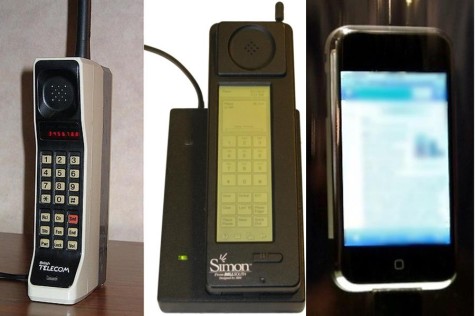
In 1992, the first smartphone named the Simon Personal Communicator, or just Simon, was created. It could receive and send calls, access email, and act as a personal data assistant, which helped define smartphones at that time. The PDA stored personal information, like contacts and appointments.
The Simon went on sale to the public in 1994, but it was doomed. It encountered setbacks, like terrible Internet connections and problems with battery life. The Center for Innovation Management Studies said that at that time, “There wasn’t enough of a technological ecosystem in place to support it.”
With improvement to the infrastructure and protocols of the Internet, practical “smartphones were introduced in mid-2007 with the introduction of the iPhone,” according to the Pew report. iPhones kickstarted other communication tech companies, like Samsung, HTC, Sony, LG, and Nokia, who were already big in the cellphone/flip phone industry.
The success of the iPhone inspired competitors to develop their own smartphones, and people were quick to accept the latest developments. In a 2011 Pew survey, 35% of Americans already owned a smartphone, and now, 58% own one.
Cellphone ownership in 2014, according to Pew, had also increased from 53% of adult owners in 2000 to 90% in 2014. Out of that 90%, two-thirds said they use their phones for Internet access, and one-third said it was their “primary Internet access point.”
While technology continues to evolve as a means to stay connected and access information via the Internet, it is predicted that users will find it nearly impossible to give up their electronics within a few years.
Photo credits: Printing Press, this image is in the public domain because its copyright has expired; Pony Express, This photo is in the public domain because it is work by an officer or employee of the United States Government as part of their personal duties; the telegraph, Swiss Federal Archives; early telephone, photo placed in the public domain by Rama of Wiki Media; ENIAC, this photo is in the public domain because it is work of the U.S. Federal government; DynaTAC 8000x, placed in the public domain on Wiki Media by owner Redrum0486; Simon, placed in the public domain on Wiki Media by the author Bcos47; iPhone photo placed in the public domain on Wiki Media by Roguegeek
Were you paying attention? Then try out our technology crossword by clicking the PLAY button below.
[twochop-public idtype=”1″ id=”2065651029087269516″]
This chapter was written by Destinee Murray.

Photo by Maile Sur
Kumu Julee Kaiaokamalie uses technology, including the Internet, in her middle school classroom. In a recent Pew Research survey, the majority of Americans felt that the Internet has been a good thing for themselves and society as a whole.
Most feel good about Web
Though it has its problems, for the most part, Americans are in love with the World Wide Web.
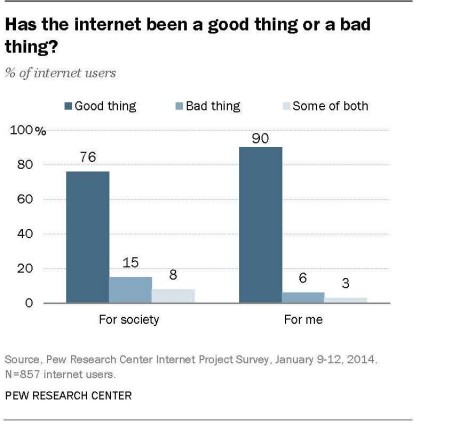 The Internet has done a lot for people and society. There are both good and bad parts to the Internet, but most agree that it has had a mostly good effect.
The Internet has done a lot for people and society. There are both good and bad parts to the Internet, but most agree that it has had a mostly good effect.
Pew Research recently released their report The Web at 25 in the U.S., and in it, the researchers asked participants to think of both the advantages and disadvantages of the Internet, then, tell whether or not “the Internet has mostly been a good thing or a bad thing for you?”
Of all the adults who said they use the Internet, 90% said that the Internet has been good for them overall, and 76% said that the Internet has been good for society.
The responses from Kamehameha Maui students were similar.
“I will admit that sometimes it’s a distraction, but with the Internet, we can access virtually every piece of knowledge ever recorded in human history. I think that is amazing!” sophomore Cole Shaffer said.
Of those in the Pew report who did not think the Internet was good overall or good for society, some said their experiences had been both good and bad, while others said they were just bad.
Junior Carolynn Krueger recalls a bad experience she had using social media on the Internet.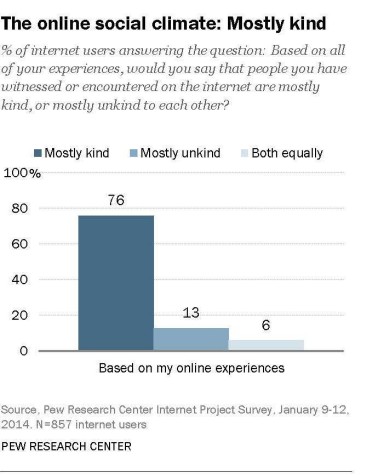
“Well on Tumblr, you can send anonymous messages to people, and there was one time when someone was sending me really awful anonymous messages, like, telling me to kill myself and things like that. So that was pretty awful,” she said.
Despite these negatives, social media and the Internet in general have also had many positive effects, bringing distant and nearby friends and family closer through photo and video sharing, blogging, posting, chatting, and messaging. People from all over the world are able to share in milestones like graduations, new babies, marriages, and other important, as well as unimportant, events.
In fact, 67% of the adult respondents in the Pew survey said that the Internet has strengthened online communications with family and friends.
In addition to the social aspects, the Internet also helps students with schoolwork and learning.
“I think the Internet has been a good thing for me because, not only has it provided me with inspiration for digital animation, but it’s also helped me learn the programs to make the animations,” said Jaclyn Gorman, a Digital Video Production student.
Photo Credits: Graphs acquired from Pew Internet Project website
This chapter was written by Daisy Draper.
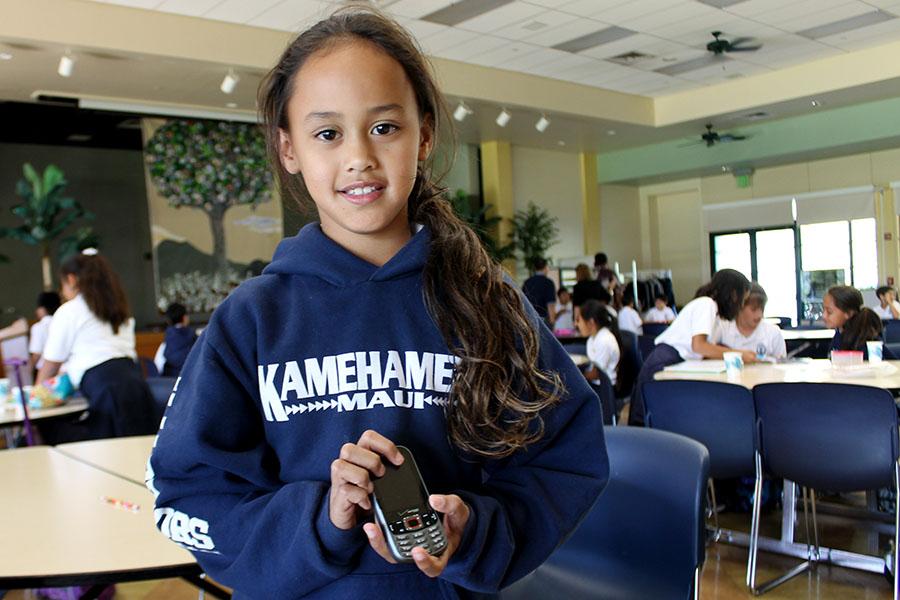
Photo by Maile Sur
Lahikina Artates, a second grader at Kamehameha Schools Maui, shows off her cellphone. As a member of Generation Z, she and her classmates accept generation innately, creating concerns among their parents.
Internet infused in lives of teens, ‘tweens, littlest beings
Generation Z is getting an early start in cyberspace, sometimes leaving a digital footprint from the womb.
*
95% of teens 12-17 are online.
92% of American children under the age of two already have a digital footprint.
46% of kids who are online report spending more than ten hours a day on the Internet.
Is anyone surprised by these numbers? It might depend on which generation you belong to.
It’s probably no surprise to Generation Y, also known as the Millennial’s. And Generation Z, the first generation born immersed in a Web-connected world, probably accept this without batting an eyelash. Their parents, the Baby Boomers and Generation X, on the other hand, have a few reservations.
Now that communication has gotten more efficient with the Web, it is easier for people to stay connected. However, it is also easier for strangers to connect with kids online. In a late 2012 Pew report entitled Parents, Teens, and Online Privacy, 72% of parents whose teens are online were concerned with how their children interact with strangers online.
The most popular tactic that parents used to address this was to speak to their children about their concerns. Two-fifths of the parents also said they worked with their teens to set up privacy settings on their children’s social media accounts.
Privacy is an important issue among parents, yet they themselves are the culprits in putting their children on the Web by posting online pregnancy updates and sonograms before their children are even born followed by pictures of them hitting major milestones as they grow up. Generation Z can already be found using a quick Google or Facebook search before they have a chance to create any accounts themselves.
AVG, an Internet security company, surveyed mothers in America, Canada, the UK, France, Germany, Italy, Spain, Australia,New Zealand, and Japan, and found that 81% of the children under the age of two in those countries already have a digital footprint. The number in America is 11 percentage points higher, thanks to connected and well-meaning parents.
- Fourth-grader Kainoa Carpenter uses the computer during class to research native Hawaiian plants.
The privacy issues raised by a generation born into a digital world aren’t the only things to worry about. There is also the concern that kids can be spending too much time on the Internet. Wikia.com surveyed more than 1,200 online users of their site. The users surveyed were between the ages of 13 and 18, and 100% of them said they spend more than an hour on the Internet a day. Almost half, 46%, said that they spend ten or more hours online per day.
Even with these worries, parents can also appreciate the good things the Internet brings. Having access to the Internet is said to make teens more aware of modern issues than previous generations. In their report Consumers of Tomorrow: Insights and Observations About Generation Z, Grail Research said that in November 2011, 74% of teenagers globally considered climate change and global warming to be a greater threat than drugs, violence or war and that Generation Z is already marked by greater social and ecological responsibility.
This chapter was written by Daisy Draper.
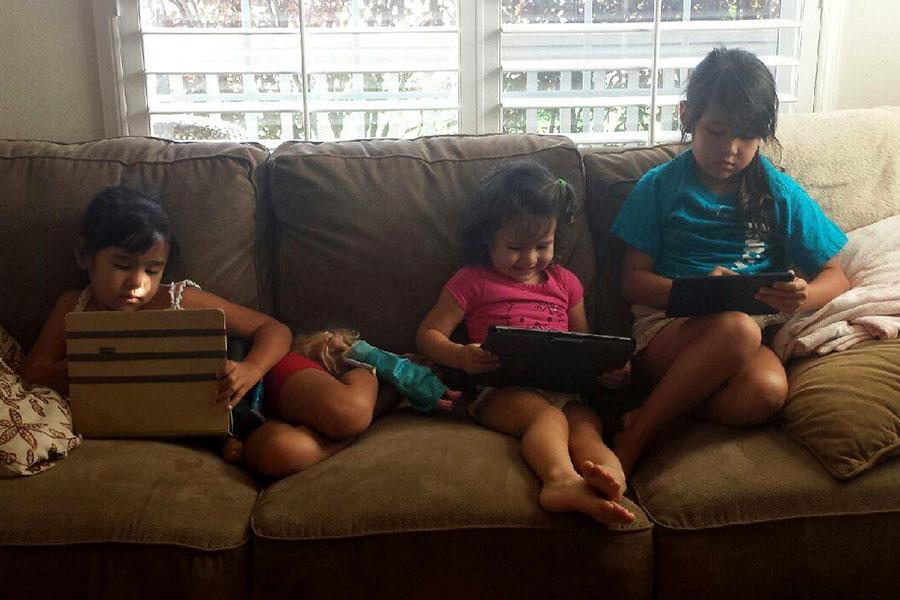
Photo by Maile Sur
Ava (4), Mailah,(2) and Chloe (6) Cuomo of Kīhei, sit at home after school playing on their iPads, while a more traditional toy, a Barbie doll, waits nearby.
Technology for toys
Kids are swapping dolls and dinosaurs for smartphones and tablets.
As the amount of technology continues to rise rapidly, the ages of its users gets lower. New technology is embedding itself in the lives of even the youngest generation.
Move over traditional toys, like basketballs and puzzles, and bring on the more modern “cool” stuff.
According to elementary school students at Kamehameha Schools Maui, that would be iPads, cellphones, and Kindles.
That wasn’t the only thing they said. For some, the answers were slightly different.
“I already have those things!” second grader Alyssa Mateo said, referring to having an iPad and a cellphone.
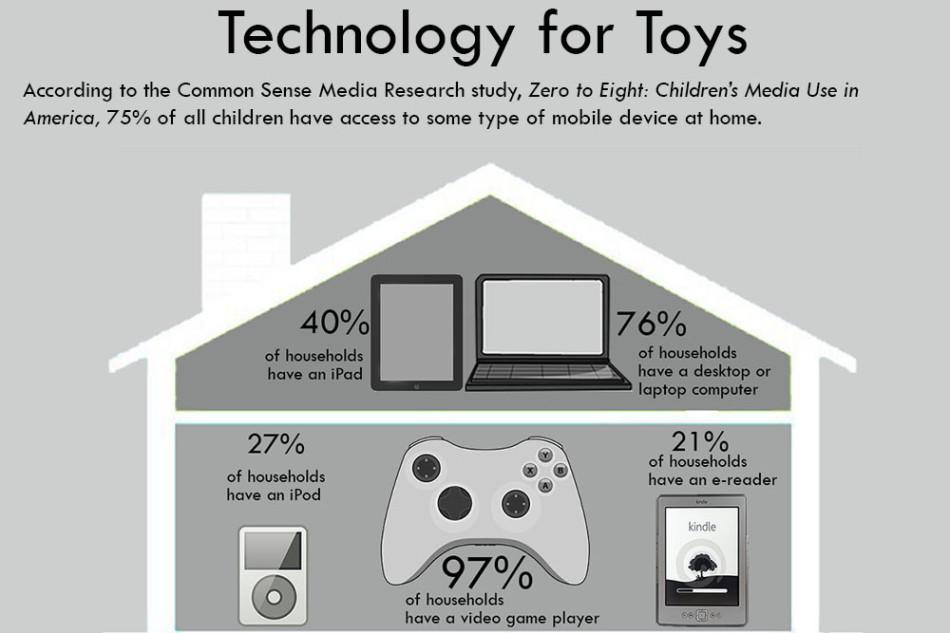
Among American children 0 to 8 years old, 75% have access to some type of mobile device at home, according to Zero to Eight: Children’s Media Use in America, a 2013 study conducted by Common Sense Media Research. This study surveyed 1,436 parents of children ages 8 and under.
These Millennials have easy accessibility to technologies that were previously considered luxury or unnecessary gadgets to generations before.
With the large amount of technology in their homes, it’s no wonder that kids are more interested and think technology is cooler than other traditional toys, and Apple products are at the forefront of the trend.
The Nielsen Company reported that iPads, iPods, and iPhones were the first, second, and third-most wanted items atop children’s Christmas wishlists in November 2011. Fourth on the list were computers, which also includes Apple products.
But, the undeniable champion of cool technology overall is cellphones.
Though the original purpose of cellphones was purely for communication, their development into smartphones has made kids now want them for fun.
Flappy Bird, Instagram, Twitter, Facebook and other apps and social media sites were on the “what’s cool” list for KS Maui elementary students.
Many debate the wisdom of giving cellphones and smartphones to children so young.
Time For Kids reports that 12 is the magic age, though 13% of kids ages 6 to 10 already have one, according to a survey by YouthBeat, a youth market report company of C & R Research.
Nearly half of 144 elementary school students surveyed at Kamehameha Schools Maui said they have a cellphone, and of those, 34% said they got their first phone at the age of 7.
“That’s pretty crazy,” junior Chanel Browne said. “Though, times are different now, so kids having cellphones isn’t that surprising.”
Teens are finding that they’re less surprised that the stuff that interests teens also interests younger brothers and sisters.

But the future isn’t all LED’s and microchips.
One group of boys on recess had a different answer to my survey.
“Kids need to get off of electronics and go outside,” third-grader Cade Cagasan said.
When he and his pals were asked what was cool, their answers were soccer, sports and “anything outdoors.”
As things are clearly changing in the world of teens and adults, its easy to see that they’re changing for kids, too.
At the same time, it’s nice to see that some students are still living real life on the playground.
This chapter was written by Maile Sur.

Photo by Daisy Draper
Retiring at the end of this year, Mr. Laxson is typical of the older generation in his use of technology. Preferring to access the Internet on a laptop. Mr. Laxson said he prefers face-to-face communication and rarely uses a cellphone for texting. That’s a good thing according to our author, Jaylin Kekiwi, as the younger generation is filled with texting do’s and don’ts for adults.
Crossing the line: The technology generation gap
Darned if you do, darned if you don’t; older generations just can’t seem to get it right in the eyes of the young
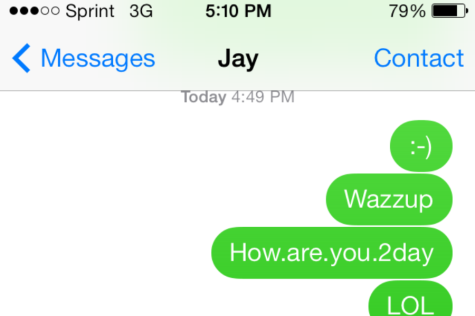
Generation gap. Noun. A frustrating lack of communication between young and old, or a useful stretch of time that separates cultures within a society, allowing them to develop their own character. See: The line between them and us.
Today, there seems to be a lot more than ethics separating the younger from the older generations – kids and their parents, even grandparents. Kids have their own unique style, their own spin on things, like with music and fashion trends to name a couple.
One of the things unique to the current generation is ubiquitous mobile technology.
Now that digital technology is practically unavoidable, it makes sense that older generations are trying to get the hang of it. Parents are texting. Grandparents are learning where the spacebar button is on a keyboard. That’s fine. We want them to be familiar with basic things so that we don’t have to come out of our rooms every time they want to capitalize a letter.
Then there are those parents who make the young cringe with some of their technology habits.
“It’s just awkward,” senior Rachel Smith said. “There’s things that [parents] just shouldn’t do.”
To help bridge the gap, here is a list of heretofore unspoken and unwritten things the older generation “shouldn’t” do in their texts:
- Send emoticons with noses
- Capitalize acronyms
- While we’re on that topic, don’t use the wrong acronym at the wrong time (We took the dog 2 the vet. LOL.)
- Using slang that no one says (“Wazzup,” anyone?)
- Using periods in place of spacing (No.you.shouldn’t.type.like.this.dad)
- Using an X for eyes (XD)
- Using “random speak” (lawlz)
- Using numbers for words (Hi, can u go 2 the store 4 groceries? Thx.)
- Shortening words (lyk dis.)
- Not proofreading for autocomplete weirdness (“Na alibi just scored,” sent from a King Kekaulike soccer game.)
They’re not the only ones with annoying habits, though. From the older generation’s perspective, we have our own annoying practices, too.
I know that one of mine, personally, is not picking up the phone when my parents are calling or not texting them back immediately after they hang up.
My dad’s classic phrase is: “Why am I paying for your cellphone if you never pick up when I call?” I think it’s safe to say that annoys him quite a bit.
My generation is one that is constantly linked to phones and laptops, making it nearly impossible for parents to connect with us unless they have phones, too, but they didn’t have the privilege of growing up with technology like we did. We’re used to the constantly-changing iPhones. Them? Not quite.
Because technology has developed, so have the guidelines of what is and isn’t acceptable. Jay Yarow with Business Insider writes, “With new technology comes new manners.” His June 2013 survey of the new acceptable technology behaviors makes for fascinating reading.
These new manners that are normal behavior for teens include things that the older generation wouldn’t dare to do, such as texting while at the dinner table and not leaving voicemail messages when people don’t pick up.
These are all things that may not seem too bad from our perspective, but considering how past generations were raised, we must seem like heathens compared to them. Do you think that there’s a possibility that they grimace every time they see young people texting in groups, like we do when we see them text periods instead of spaces?
Maybe the older generation aren’t the only ones who have something to learn about bridging the generation gap. Maybe we could both work to erase the line between them and us.
This chapter was written by Jaylin Kekiwi.

Photo by Destinee Murray
Violet Purdy, 88, of Ulupalakua checks out an iPhone. She is one of the 13% of Americans who do not use the Internet. She just got her own flip cellphone three months ago, and, so far, uses it only to take incoming phone calls.
Status: Offline
In this tech-infused world, who is steering clear of the information highway?
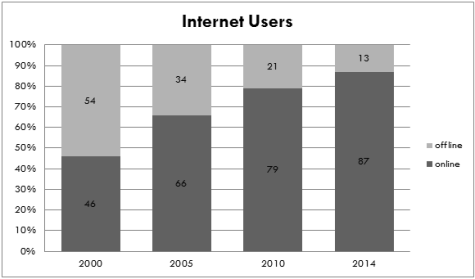
Pew Research Center reported that the amount of adults using the Internet increased to 87% in 2014, which was 2% more than in the previous year; however, that means that 13% of adults still weren’t going online. This, of course, begs the question: Why not?
“It’s too confusing,” Violet Purdy of Ulupalakua said. “I don’t know how to work that thing [a computer and the Internet].”
The 2013 report data reveal that the older the age group, the less likely the members were to use the Internet. In fact, 8% of respondents said that one reason for not getting online was that they were “too old to learn.”
Some might presume that that segment of the older generation isn’t getting online because they weren’t exposed to this kind of technology when they were growing up, so it might be harder for them to learn the nuts and bolts.
However, that’s only half the story. Most respondents said they were “just not interested.” Combined with “too busy,” “waste of time,” and “don’t need/want it,” these four answers accounted for 34% of the reasons offline adults don’t use the Internet.
“I don’t want to deal with that,” Purdy said of going on the Internet. She explained that technology had too many aspects for her to learn, and said that the Internet has “dangerous things on there.”
Usability issues like “worried about privacy/spam/hackers/spyware/viruses,” “too difficult or frustrating,” “don’t know how,” and “physically unable” were nearly equal in importance to relevance issues, accounting for 32% of the answers.
Relevance as a problem has dropped 14% since 2010; however, the problem with usability has increased by 14% in that same time.
Although unplugged adults are offline for various reasons, 33% say they have been exposed to the Internet. They either used the Internet before and stopped for unknown reasons or live with someone else who uses the Internet for them.
Home access could also be affected by seniors’ ability to afford devices and the Internet for it to connect to.
In Digital Life in 2025, Prof. Jannie Anderson, Lee Rainie and Maeve Duggan propose 15 theses about a digital future, supporting expert predictions that “the Internet will become ‘like electricity’ — less visible, yet more deeply embedded in people’s lives for good and ill,” but caution that a future so reliant on technology could further divide the have’s and the have-not’s.
While the reasons adults aren’t using the Internet varied, the slow decrease in those who aren’t online and the quickly increasing size of Generation V (people comfortable with technology) could point to a future in which 100% of Americans eventually get plugged in.
This chapter was written by Destinee Murray.![‘Been around the world, [do YOU] speak the language?’](https://kaleoonakoa.org/wp-content/uploads/2014/03/Jaye-Lyn-Orikasa-_-March-13-2014-_-SurM.jpg)
Photo by Maile Sur
Junior Jaye-lyn Orikasa checks Twitter during class. “We all do it.” she said. With so much to say and so little time to say it, texters have come to rely on shortcuts and acronyms to save time and thumb energy. In this article, we have a little fun with it.
‘Been around the world, [do YOU] speak the language?’
What do your acronyms say about you?
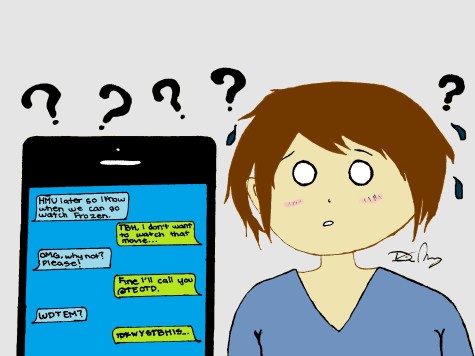
I couldn’t help thinking of the Jason Derulo lyrics “been around the world, don’t speak the language” when I wrote this because there’s a new language around.
You all use it, and there’s no sign of it dying out anytime soon.
This is the language of acronyms used in the everyday practice of texting.
Take a look at some of the commonly used ones in the lists below.
Judging by these two lists, where do you fall? Is your “text talk” in desperate need of an upgrade, or are you savvy with the latest terms? Let us know in the comments!
Old School
- OMG – oh my God
- LOL – laughing out loud
- JK – just kidding
- ASAP – as soon as possible
- BTW – by the way
- ILY – I love you
- IDK – I don’t know
- GTG /G2G – I have to go/I got to go
- BRB – be right back
- NP – no problem
- WBU – what about you?
- NVM – never mind
- TMI – too much information
So Cool
- HMU – hit me up
- IDC – I don’t care
- IMO – in my opinion
- IRL – In real life
- TBH – to be honest
- SMH – shaking my head
- KK – okay
- LMK – let me know
- JSYK – just so you know
- JS – just saying
These are the most common ones we could come up with our savvy selves that aren’t completely ridiculous (like WDALYC or “who died and left you in charge?”) You know, some things are just better spelled out.
Just for fun, click the PLAY button below and take our silly quiz on some of the weirder acronyms floating around.
[twochop-public idtype=”1″ id=”16044824272445289102″]
This chapter was written by Jaylin Kekiwi.
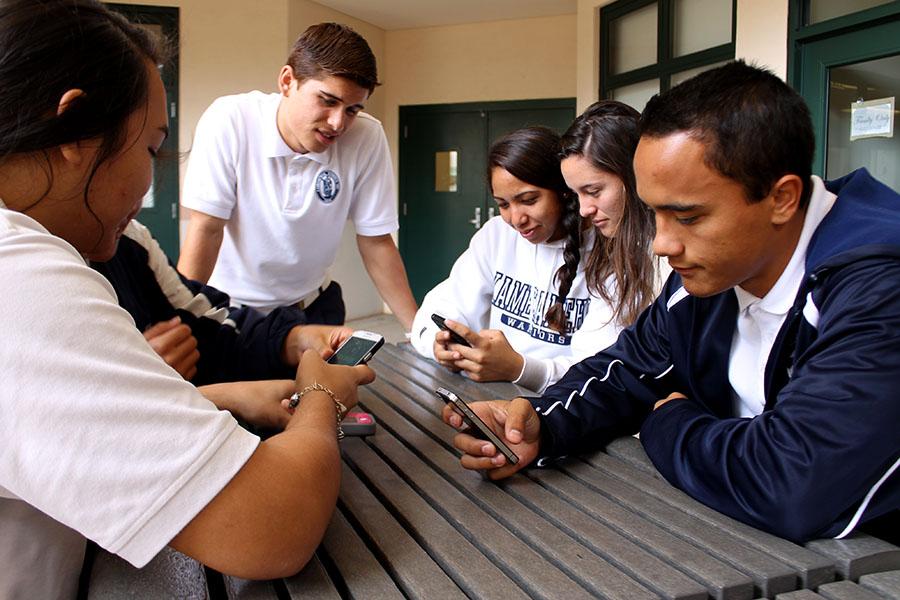
Photo by Maile Sur
Just like in the video, “I Forgot My Phone,” students at Kamehameha Schools Maui are sometimes too preoccupied with their technology to pay attention to others speaking right in front of them.
Time to unplug
But, are we stuck in the outlet?
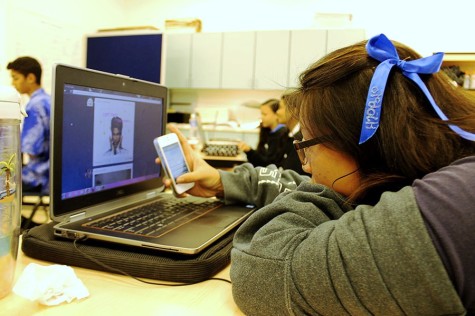
Everywhere we go people are on their phones, tablets, and other mobile devices. Though technology has many everyday benefits, its constant presence in every aspect of our lives may be reaching the tipping point.
America may be facing a crisis when it comes to technology addictions.
Thanks to Steve Jobs, Bill Gates, and other media developers, technology is everywhere — in the workforce, in homes and in schools. These technologies have gone from being simple tools used occasionally, to, for some, a lifeline.
People can’t even put their phones down while completing routine tasks like driving, walking, shopping, eating dinner, and even, using the bathroom.
“I think all teens can admit to texting in class” said junior Jaye-lyn Orikasa. “We all do it.”
It’s true.
Students are always bringing out their phones in class, at assemblies, and during sporting events.
“I’m on [my phone] about 70% of the time,” KS Maui junior Rachel Kaulupali said. “Checking Instagram, Snapchat, or just looking to see if I got a text.”
The Pew Research Center reported that for 49% of phone and Internet users, it would be “impossible” to give up their cell or smartphones and “very hard” for 53% of people to give up the Internet.
For many of these people, the Internet and technology have become deeply woven into their routines. For instance, they’ve ditched their traditional alarm clocks for the ones on their phones, they use iTunes to download music instead of actually buying a CD, and Netflix has become the new movie theater.
In short, America has become addicted to technology.
In a 2010 article by Mark Milian for CNN, Apple co-founder Steve Wozniak said, “We’re dependent on it, and eventually, we are going to have it doing every task we can in the world, so we can sit back and relax.”
He has a point. People used to do things manually — mail letters, use maps, and actually, physically, talk to people in person. Now, mail is sent virtually, Google Maps literally tells us where to go, and Facetime and Skype pass for conversation daily.
In comedienne Charlene deGuzman’s YouTube video accompanying this article, she illustrates the problem so well, that her video has now been viewed over 39 million times.
Entitled “I Forgot My Phone,” her video (embedded at the top of this story) shows a series of everyday events in which people’s ordinary and special moments are interrupted by social media and technology. In an interview for The New York Times, deGuzman said, “It makes me sad that there are moments in our lives when we’re not present because we’re looking at a phone.”
Can people truly enjoy events when they’re so busy recording them?
Dr. Linda Henkel, from Fairfield University, doesn’t think so.
She and a team of researchers identified a condition known as the “photo-taking impairment effect.” Sarah Knapton, science correspondent for The Telegraph, wrote about the study in a December 2013 Web article.
Henkel’s study suggests that taking pictures instead of actually focusing on an event could prevent people from fully remembering details of the event.
“When people rely on technology to remember for them – counting on the camera to record the event and thus not needing to attend to it fully themselves – it can have a negative impact on how well they remember their experiences,” she said.
Other experts chime in on the topic of taking too many digital pictures.
In Michael Sacasas’ post “Living for the Moment in the Age of Memory Abundance” for Second Nature Journal, he wrote, “Gigabytes and terabytes of digital memories will not make us care more about those memories, they will make us care less.”
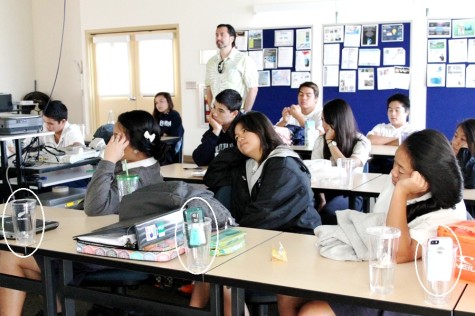
Despite concerns raised by people like Henkel and Sacasas, tech-savvy people will probably continue to bring out their devices at every memorable moment.
As tech businesses continually come up with new ways for people to take and share pictures, people are going to want try the new gadgets without a glance back at tradition.
Society is already beginning to push back against the trend. Some events provide photographers and videographers, some make announcements about enjoying live performances, and some places even ask people to check phones and cameras at the door.
Rather than waiting for others to tell them to put their phones away, maybe the time is not too far off when Americans will decide for themselves that, sometimes, it’s just time to live life and get unplugged.
This chapter was written by Maile Sur.
